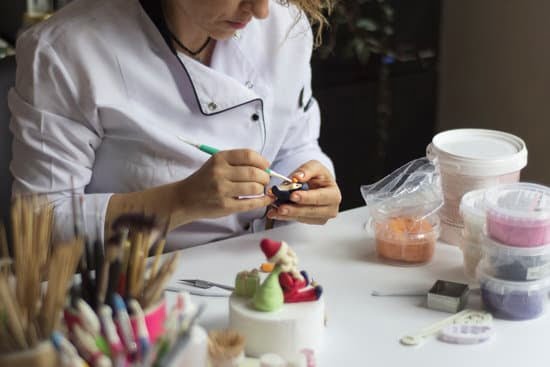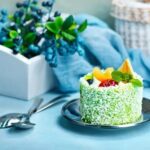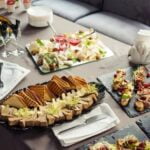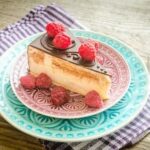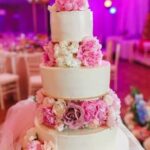Buttercream painting has become a popular trend in the world of cake decorating, captivating both professional bakers and enthusiastic home cooks. This innovative technique allows artists to transform an ordinary cake into a masterpiece, using buttercream icing as their canvas. With its versatility and limitless creative possibilities, buttercream painting is taking the cake decorating world by storm.
Traditionally, cakes were adorned with intricate designs using sugarpaste or fondant. However, buttercream painting offers a more painterly approach, allowing decorators to harness their artistic skills and create stunning edible works of art. By utilizing various techniques like brush strokes, blending, and texture building, bakers can achieve captivating effects that bring cakes to life.
One of the reasons buttercream painting has gained such popularity is its accessibility. Unlike fondant techniques that require specialized tools and extensive training, buttercream painting can be easily mastered by beginners in the comfort of their own kitchens. With just a few essential tools and some creativity, anyone can create visually striking cakes that will impress guests and clients alike.
So whether you’re a seasoned baker looking to expand your repertoire or someone who simply wants to add a personal touch to their next celebration cake, join us as we delve into the exciting world of buttercream painting. From basic techniques to advanced tips and tricks, we’ll guide you through everything you need to know to unlock your inner cake artist.
Get ready for a journey filled with inspiration from nature, abstract designs that push boundaries, themed cakes for special occasions, troubleshooting common challenges faced by decorators – and most importantly – sheer delight in creating delectable delights that are truly unique.
How to prepare the buttercream canvas
Gathering the Materials and Tools
Before preparing the buttercream canvas, gather all the necessary materials and tools. These include a fully baked cake of your choice, buttercream icing in your desired colors, a palette knife for smoothing the icing, piping bags for more detailed work, various food colorings for adding detail and depth to your design, and brushes specifically designed for cake decorating. It is essential to use brushes that are food-safe and that have bristles suitable for working with buttercream.
Preparing the Cake
To prepare the buttercream canvas, start by leveling the top of your baked cake to ensure an even surface. This can be done using a serrated knife or a cake leveler. Once leveled, place the cake on a cake board or plate that is slightly larger than the size of your cake.
Next, crumb coat the entire cake with a thin layer of buttercream icing. This helps seal in any crumbs and provides a smooth base for painting. Use a palette knife to spread an even layer of icing over all sides of the cake. Take care to fill in any gaps or uneven spots to create a level surface.
After applying the crumb coat, refrigerate the cake for about 15-20 minutes to allow it to set and firm up. This will make it easier to apply the final layer of buttercream.
Once chilled, apply a second layer of buttercream over the crumb coat using smooth strokes with your palette knife. Work from top to bottom while rotating the turntable if you’re using one. The goal is to achieve an even and smooth surface on all sides of the cake.
Achieving Proper Icing Consistency
To achieve proper icing consistency for buttercream painting, it is important to find the right balance between being too stiff or too runny. If your buttercream is too stiff, it will be difficult to spread smoothly. On the other hand, if it is too runny, it may not hold its shape or provide the desired level of control for painting.
To achieve the perfect consistency, start by preparing your buttercream icing according to your preferred recipe. If it is too stiff, gradually add small amounts of liquid, such as milk or water, until it reaches a more spreadable consistency. Conversely, if it is too runny, add powdered sugar in small increments until you reach the desired consistency.
Take note that different cake decorators may prefer different consistencies based on their painting techniques and preferences. As you gain experience through practice, you will have a better understanding of the ideal icing consistency that works best for your desired designs.
By following these step-by-step instructions and paying attention to achieving a smooth surface and proper icing consistency, you will have a well-prepared buttercream canvas ready for your cake painting adventure.
Essential tools and materials
To achieve stunning buttercream paintings on cakes, it is essential to have the right tools and materials. These items will not only make the process easier but also help you achieve professional-looking results. Here are some of the essential tools and materials needed for buttercream painting:
- Palette Knife: A palette knife is a must-have tool for buttercream painting. It allows you to smoothly apply and blend buttercream onto the cake surface, creating a perfect canvas for your artwork.
- Piping Bags: Piping bags are indispensable for creating fine details and intricate designs on your cake. Opt for reusable or disposable bags depending on your preference and convenience.
- Food Colorings: Various food colorings are required to create a vibrant and visually appealing buttercream painting. Gel-based colorings work best as they provide intense pigmentation without altering the consistency of the buttercream.
- Brushes: Invest in brushes specifically designed for cake decorating. These brushes have soft bristles that allow you to achieve precise strokes and details in your artwork.
In addition to these essential tools, there are other optional materials that can enhance your buttercream paintings:
- Edible Dusts: Edible dusts add a hint of shimmer and sparkle to your painted designs, making them look even more eye-catching.
- Stencils: Using stencils can help create consistent patterns and shapes effortlessly, especially if you’re new to buttercream painting.
- Offset Spatula: An offset spatula is an alternative to a palette knife that allows you to spread buttercream smoothly on the cake’s surface while keeping your hands away from touching it.
Before starting with your buttercream painting project, ensure that all your tools and materials are clean and ready for use. This will ensure optimal performance and prevent any unwanted contamination of colors or textures in your artwork.
Basic buttercream painting techniques
Buttercream painting is a beginner-friendly technique that allows for creative and artistic cake decorating. In this section, we will explore some basic buttercream painting techniques that can be easily mastered by those new to the art form. These techniques include brush stroke blending, watercolor effects, and creating textured finishes using buttercream.
Brush stroke blending is a fundamental technique in buttercream painting. To achieve this effect, start by applying a base layer of buttercream in the desired color onto your cake canvas. Then, using a clean paintbrush or palette knife, gently blend different shades of colored buttercream onto the surface. This will create beautiful gradients and smooth transitions between colors.
Watercolor effects can also be achieved with buttercream. Begin by adding small drops of food coloring or edible paint onto your cake canvas. Using a clean, damp paintbrush, lightly blend the colors together on the surface of the cake. This technique creates a soft and ethereal appearance that mimics watercolor paintings.
Creating textured finishes is another technique that adds dimension to your buttercream painting. To achieve texture, use various tools such as spatulas, combs, or even piping bags fitted with different tips to create patterns and designs on the cake’s surface. This technique allows you to add depth and visual interest to your artwork.
To help you visualize these techniques and put them into practice, refer to the accompanying visuals provided in this article. Additionally, detailed instructions are included below each visual to guide you through each step of the process.
By mastering these basic buttercream painting techniques, you’ll be well on your way to creating beautiful works of art on your cakes. Remember to start with small projects and gradually build up your skills as you gain experience and confidence in using these methods. Don’t be afraid to experiment and let your creativity shine through in every brushstroke.
| Buttercream Painting Techniques | Description |
|---|---|
| Brush Stroke Blending | Create smooth gradients and transitions between colors by blending different shades of colored buttercream. |
| Watercolor Effects | Add drops of food coloring or edible paint onto the cake canvas and blend them with a damp paintbrush to achieve a soft, watercolor-like appearance. |
| Creating Textured Finishes | Use various tools like spatulas, combs, or piping bags with different tips to create patterns and designs that add depth and visual interest to the cake. |
Inspiration from nature
Floral Designs
Floral designs are one of the most popular and timeless options for buttercream painting on cakes. From delicate roses to vibrant sunflowers, there is no shortage of inspiration when it comes to floral buttercream designs. To create a stunning floral cake, start by selecting a color palette that complements the flowers you wish to paint.
For example, pastel shades like pink, lavender, and yellow work well for roses and peonies, while bold colors like red and orange are ideal for tulips and poppies. Use thin brushes or piping bags with small round tips to create intricate details in petals, leaves, and stamens. Consider adding dimension by applying different shades of the same color or using petal dust to add depth and shading.
Sunsets
Sunsets are a captivating natural phenomenon that can be beautifully captured through buttercream painting on cakes. Begin by creating a smooth canvas with a gradient background that transitions from warm hues at the horizon to softer tones at the top. Yellow, orange, pink, and purple are commonly used colors for sunset-inspired cakes.
Blend these colors together using horizontal brush strokes or by blending them directly on the cake using a palette knife. For added visual interest, consider incorporating silhouettes of palm trees or birds against the vibrant sunset backdrop.
Landscape Scenes
Landscape scenes offer endless possibilities for showcasing your buttercream painting skills on cakes. Whether you want to recreate rolling hills, serene lakesides, or picturesque mountainscapes, landscapes allow you to experiment with various textures and techniques. Start by sketching out your desired scene on the cake using toothpicks or edible markers as guides.
Next, apply layers of buttercream icing in different shades of green for grassy areas or blue for water features. Utilize small spatulas or brushes to create texture through gentle strokes that mimic the movement of trees, waves, or grass. Add details like flowers, rocks, or cottages to bring your landscape to life and complete the cake’s design.
Animal Portraits
For those who enjoy a challenge and want to incorporate animals into their buttercream painting designs, animal portraits can be a visually striking choice. Begin by selecting an animal that you wish to paint on your cake-popular options include butterflies, owls, and pandas. Get familiar with the anatomy and characteristics of the chosen animal to ensure accuracy in your depiction.
Start by applying the base colors and gradually add layers for shading and highlighting to create depth. Use small brushes or even toothpicks for fine details such as facial features or fur patterns. Remember that patience and attention to detail are crucial when capturing animal portraits through buttercream painting.
When it comes to nature-inspired buttercream painting ideas, there are countless possibilities waiting to be explored. Whether you choose floral designs, sunsets, landscapes, or animal portraits for your cake creations, always remember that practice makes perfect.
Experiment with different color combinations, brush techniques, and texture applications until you find your own unique style. By drawing inspiration from the world around us, you can create breathtakingly beautiful cakes that not only taste delicious but also showcase your artistic talent as a cake decorator.
Abstract and modern designs
Abstract and modern designs:
When it comes to buttercream painting, there is no limit to creativity. Abstract and modern designs offer a unique opportunity to create visually striking cakes that break away from traditional styles. From geometric patterns to abstract art and minimalist designs, these techniques allow decorators to explore new ways of expressing their artistic vision using buttercream as their medium.
To achieve precision in abstract and modern designs, it is important to have a clear plan in mind before starting the painting process. Sketching out the design on paper or using stencils can help ensure clean lines and accurate shapes. Additionally, using a piping bag with a fine tip or a small paintbrush can help achieve intricate details.
One popular technique for creating geometric patterns is the use of masking tape or stencils. By applying these tools onto the cake surface before painting, decorators can create sharp, defined lines that result in a sleek and modern look. The tape or stencil can be removed once the icing has dried, revealing clean edges.
For those interested in abstract art, experimenting with different strokes and textures can add depth and interest to the design. Using various brush sizes and types can create dynamic effects on the cake surface. It’s also important to consider color combinations that complement each other well and evoke the desired mood or theme.
Minimalist designs focus on simplicity and clean lines. They often involve only one or two colors with minimal embellishments. Achieving precision in minimalist designs requires careful planning, precise measurements, and attention to detail.
With practice and experimentation, decorators can create impressive cakes that truly stand out. Abstract and modern buttercream painting styles offer endless possibilities for those looking to push their creative boundaries in cake decorating.
| Tools | Materials |
|---|---|
| Palette knife | Buttercream icing |
| Piping bags | Food colorings |
| Various brushes | Cake surface primer (buttercream icing) |
Advanced techniques and tips
Once you have grasped the basic techniques of buttercream painting, it’s time to take your skills to the next level with advanced techniques that will truly elevate your cake decorating game. In this section, we will explore more intricate methods such as shading and highlighting, creating realistic textures, and using stencils to achieve professional-looking designs.
Shading and highlighting add depth and dimension to your buttercream paintings, making them visually captivating. To shade, start by applying a base color onto your canvas and then gradually add darker shades using a small brush or spatula. Blend these colors together gently to create a smooth transition.
Highlighting is done by adding lighter shades to areas where light would naturally hit, such as the edges or raised portions of your design. This technique creates a sense of three-dimensionality and brings your painting to life.
Creating realistic textures with buttercream can be achieved through various methods. For example, if you want to create the illusion of wood grain or tree bark, use a piping bag fitted with a small round tip to create delicate lines in different shades of brown on top of your base color. You can also use a textured sponge or stencil specifically designed for cake decorating to achieve interesting patterns like brick walls or lace textures.
Stencils are invaluable tools when it comes to achieving precise details in buttercream painting. They allow you to effortlessly replicate intricate designs onto your cake canvases. To use stencils effectively, secure them firmly onto the surface of your cake using tape or magnets. Using an offset spatula or palette knife, apply a thin layer of colored buttercream over the stencil openings being careful not to smudge the design. Carefully remove the stencil and voila. Perfectly replicated patterns with minimal effort.
As you experiment with these advanced techniques, remember that practice makes perfect. It may take some time and several attempts before you master them, but don’t get discouraged. Keep practicing, watch tutorials, and study cake decorating books or online resources to continue learning and improving your skills.
In the next section, we will explore how buttercream painting can be incorporated into special occasion cakes, offering innovative ideas and themes for themed cakes.
Special occasions and thematic cakes
Special occasions and themed cakes provide the perfect opportunity to showcase your buttercream painting skills and create truly memorable edible works of art. Whether it’s a wedding, birthday, or holiday celebration, incorporating buttercream painting into these special events can take your cake decorating to new heights. Here are some innovative ways to incorporate buttercream painting into special occasion cakes:
- Wedding Cakes: Buttercream painting offers endless possibilities for creating stunning wedding cakes that match the theme and style of the couple’s special day. One idea is to paint delicate floral designs cascading down the tiers of the cake, using soft pastel colors and intricate brushwork. Another option is to create a romantic watercolor effect with shades of blush pink, ivory, and gold, evoking a sense of elegance and beauty.
- Birthday Cakes: For birthday celebrations, consider incorporating the birthday person’s favorite hobbies or interests into the design. For example, if they love gardening, paint a vibrant flower garden scene on the cake with bright colors and realistic details. If they’re a fan of superheroes or princesses, create a themed cake showcasing their favorite characters using buttercream painting techniques.
- Holiday Cakes: Buttercream painting can bring festive cheer to holiday celebrations. For a winter wonderland-themed cake, paint snowflakes in shades of blue and silver onto a white buttercream canvas, adding shimmering touches with edible metallic paints or luster dust.
A tropical paradise-themed cake can feature palm trees, exotic flowers, and vibrant sunset hues like orange and pink for a summery feel. And for an underwater scene on a beach-themed cake, use shades of blues and greens to create waves, fish, coral reefs, and other marine elements.
When incorporating buttercream painting into special occasion cakes, keep in mind that attention to detail is key. Use fine-tipped brushes for precise work and experiment with different color palettes to evoke the desired atmosphere or theme. Additionally, remember to coordinate the buttercream painting with other decorative elements such as fondant accents, edible pearls, or fresh flowers to elevate the overall design.
By incorporating buttercream painting into special occasion cakes, you can create edible masterpieces that will wow your guests and add an extra touch of personalization to any celebration. Let your creativity shine and experiment with different techniques and themes to bring your vision to life on a cake canvas.
Troubleshooting common challenges
Buttercream painting is a versatile and creative technique in cake decorating; however, like any art form, it comes with its own set of challenges. Understanding and troubleshooting these challenges will help aspiring bakers and cake decorators achieve their desired results. In this section, we will address some common issues encountered during buttercream painting and provide practical solutions to ensure successful cake decorating.
One common challenge when working with buttercream painting is color bleeding. This occurs when colors blend together more than intended, resulting in a muddled effect. To prevent color bleeding, it is important to ensure the buttercream canvas has fully crusted before applying additional colors. Waiting until the surface is dry to the touch will create a barrier that helps prevent colors from smudging or blending together too much.
Overmixing can also pose a problem when working with buttercream for painting purposes. Overmixing can lead to air bubbles in the icing, which can affect the smoothness of the painted surface. To prevent this issue, it is best to mix your buttercream on low speed and avoid over-mixing. Additionally, tapping the mixing bowl gently on the countertop after mixing can help release any remaining air bubbles.
Achieving precise details in buttercream art requires practice and patience but can be challenging for beginners. One valuable tip is to use a small round brush with firm bristles for fine lines and delicate details. Dip the brush in water before dipping into food coloring to dilute it slightly for better control over thin lines or intricate designs. Another helpful technique is using stencil templates or piping tips with different shapes and sizes to achieve consistent shapes or patterns.
By addressing these common challenges and using practical solutions like ensuring proper drying time, avoiding overmixing, using appropriate brushes, and utilizing tools like stencils or piping tips, cake decorators can overcome hurdles in buttercream painting. Remember, practice is key, and experimenting with different techniques will help refine skills over time. With dedication and persistence, aspiring bakers can master the art of buttercream painting and create stunning works of edible art.
Conclusion
In conclusion, buttercream painting is a versatile and rewarding technique in cake decorating that has been gaining popularity among bakers and cake enthusiasts.
In this article, we have explored the concept of buttercream painting, provided step-by-step instructions on how to prepare the buttercream canvas, highlighted the essential tools and materials needed, explained various beginner-friendly techniques, showcased nature-inspired and abstract designs, discussed advanced techniques and tips, suggested innovative ways to incorporate buttercream painting into special occasion cakes, and addressed common challenges.
Buttercream painting offers endless possibilities for creativity and expression. Whether you are a beginner or an experienced cake decorator, this technique allows you to bring your artistic vision to life on a cake. By experimenting with brush stroke blending, watercolor effects, textured finishes, shading and highlighting, creating realistic textures, using stencils and more, you can achieve stunning results that will impress both yourself and others.
For beginners just starting out with buttercream painting, it is important to remember a few key tips. Firstly, practice makes perfect – don’t be discouraged if your first attempts don’t turn out exactly as planned. Keep practicing and refining your skills. Secondly, start with simple designs and gradually work your way up to more complex creations. And finally, don’t be afraid to experiment and try new things – let your creativity flow.
We would love to see what you create using the buttercream painting technique. Feel free to share your own creations with us – tag us on social media or send us photos via email. We hope this article has inspired you to explore the world of buttercream painting in cake decorating. Happy baking.
Frequently Asked Questions
What do you use to paint on a buttercream cake?
When it comes to painting on a buttercream cake, you have a few options to choose from. One commonly used tool is food-safe gel or powdered colors. These types of colors are highly concentrated and can be mixed with a bit of water or alcohol to create a paint-like consistency.
Another option is edible dust or petal dust, which is finely ground powder that can be mixed with clear alcohol or lemon extract to form a paint mixture. Additionally, some decorators prefer using edible food color pens for smaller details or fine lines.
How do you paint buttercream on a cake?
Painting buttercream on a cake requires some skill and technique, but it can yield stunning results. Before you begin painting, make sure your buttercream is smooth and chilled. It’s best to start with a base color or pattern on the cake before adding any intricate designs.
To apply the paint, use clean brushes that are dedicated solely for food decoration purposes. Dip your brush into the paint mixture and apply it gently onto the buttercream surface, working in small strokes or layers as needed. Let each layer dry before adding additional colors or details to avoid smudging the design.
What buttercream is best to paint on?
The type of buttercream that works best for painting depends on personal preference and desired aesthetics. Swiss meringue buttercream and Italian meringue buttercream are popular choices due to their smooth texture and stability at room temperature once set. These types of buttercreams provide a good surface for painting, allowing the colors to adhere well without excessive smearing or bleeding.
American buttercream can also be used for painting but may require additional chilling time before applying the design due to its softer consistency at room temperature. Ultimately, the key is to ensure that your chosen buttercream has been properly prepared and layered onto the cake for optimal results when it comes time to paint.

Welcome to our cake decorating blog! My name is Destiny Flores, and I am the proud owner of a cake decorating business named Cake Karma. Our mission is to provide delicious, beautiful cakes for all occasions. We specialize in creating custom cakes that are tailored specifically to each customer’s individual needs and tastes.

